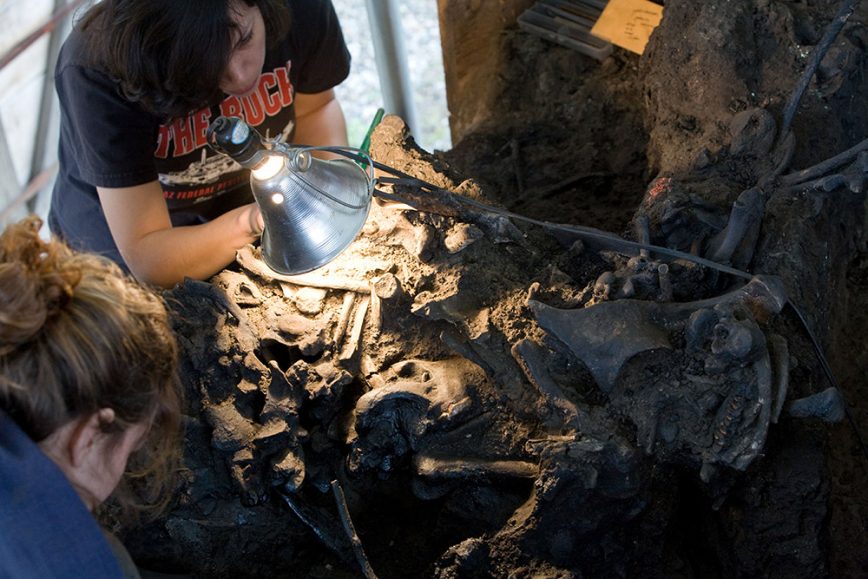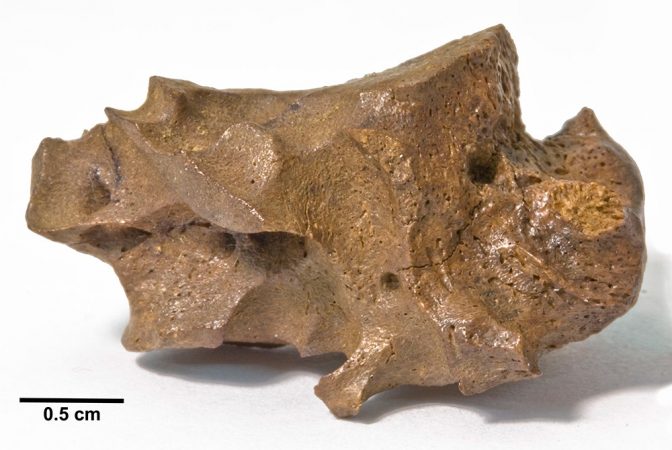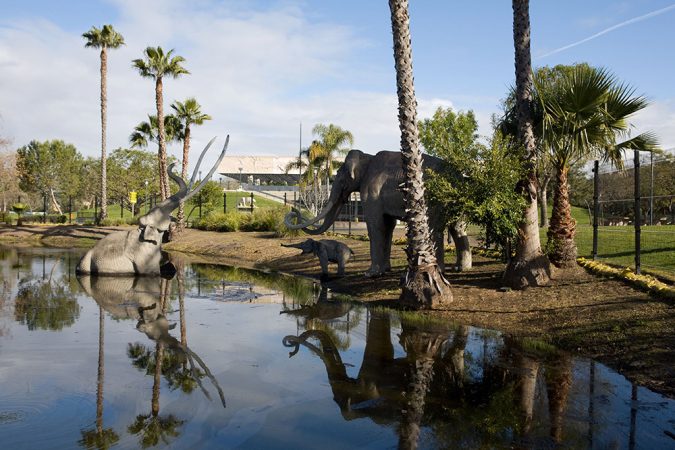Tar pit bones yield climate clues
Insect damage to ancient bones reveals length of ‘summer’ during the last ice age

Paleontologists and volunteers have excavated millions of bones from the La Brea tar pits since the late 1800s. Insect damage on some of those fossils is now providing scientists with clues about climate during the last ice age.
Page Museum at the La Brea Tar Pits
By Sid Perkins
During the last ice age, more than 12,000 years ago, many unusual creatures wandered Southern California. Some got trapped in tar pits there. Now, their preserved remains are providing scientists with clues about summer weather during that bygone era.
The fossils indicate the Los Angeles area had a summer season that at times stretched to four months, maybe more. Considering it was the “ice age,” that came as a surprise, says Anna Holden. As a paleoentomologist, she studies ancient insects. She works at the Natural History Museum of Los Angeles County, which is located near the tar pits.
Her new findings on ice age summers emerged while studying an unusual type of fossil.
The term fossil usually brings to mind dinosaurs like Tyrannosaurus rex or ice-age creatures like mammoths. Their fossil remains often are preserved bones or fearsome teeth. Paleontologists call these “body” fossils because they provide an idea of what an animal would have looked like.
But fossils can be any trace of an ancient living thing. Footprints, burrows or chew marks on a bone are also considered fossils. Such “trace” fossils can provide information that’s more valuable than body fossils. For instance, trace fossils can hint at a creature’s behavior. Evidence of that is usually scant.
Holden didn’t have to go far to find her fossils. Scientists have excavated — or dug up — the remains of many creatures near downtown Los Angeles. They were entrapped in the La Brea tar pits (“brea” being the Spanish word for tar).
Many of the pit fossils come from extinct creatures, such as saber-toothed cats and the elephant-like mammoths and mastodons. Others belong to species that died out in that area but whose relatives still survive elsewhere. These include lions, horses and camels. Still more remains are fossils of creatures that continue to live nearby, such as birds and beetles.
The La Brea site trapped a large number of its animals in summer. That’s when the tar becomes gooey and sticky. Even a layer less than 4 centimeters (1.6 inches) thick can trap an animal the size of a cow, earlier studies have suggested.
And when big creatures became trapped, many of their predators and scavengers did too, notes Holden.
In their new analysis, Holden and other researchers examined tar pit body fossils for insect damage. Dead bodies attract many types of insects, including flies, wasps and beetles. The insects lay their eggs on the carcass. Later, when the eggs hatch, the larvae feed on the soft tissues and bones. Besides offering clues to an ancient ecosystem — who was eating who, for example — the insect damage can hint at what past climates were like.
Only certain types of bones showed insect damage, the researchers found. Bones of birds and carnivores (meat-eaters) showed none. Among herbivores (plant-eaters), nearly all insect-damaged bones came from the feet.

A little thought helps explain these patterns, says Holden. The feet and legs of most meat eaters, especially birds, contain little soft tissue. So, there would be little to nourish the growth of flesh-eating insect larvae. But the feet of plant eaters could be quite fleshy. That would make them a more tempting target for egg-laying insects. What’s more, once the thick skin of an herbivore’s foot dried out, it provided a well-protected container in which fragile larvae could feed almost undisturbed. Finally, Holden notes, foot bones sometimes have spongy surfaces, making them easy for a hungry larva to bore into.
“It’s intriguing to see that only some of the bones had [insect] damage,” says Anthony Martin. As an ichnologist at Emory University in Atlanta, he specializes in studying trace fossils. He did not, however, work on the new study.
Two types of beetles made the most common trace fossils that Holden’s group found at the tar pits. One type, called dermestid beetles, is frequently used by biologists, museum workers and forensic scientists. These beetles eat the flesh off of bones the researchers want to analyze. The other type of beetle is the little-studied tenebrionid (teh-NEB-ree-onn-nud). These are often attracted to dead animals. But biologists had thought these insects consumed only soft tissue, not bone, Holden notes.
To confirm the findings, her team conducted lab tests. The researchers offered both types of beetle larvae a variety of food: chicken bones, pork ribs and certain foot bones from horses and sheep. Then, they checked the bones every few days for any damage. That gave them the data they needed to better understand the trace fossils they had seen on the tar pit bones.
Few foot bones from herbivores in the La Brea tar pits showed insect damage. But some of those that did had larva-munched pits 2.5 millimeters (0.1 inches) across. That’s a little larger than the diameter of a pencil lead. For the larvae to have hatched, grown and created that much damage on the ancient bones, they must have been exposed for at least 17 to 20 weeks before sinking into the tar, Holden explains.
The beetle larvae that damaged these bones only develop in warm or hot months. That fact helped Holden and her team estimate the length of the summer tar-melting season in Los Angeles during the warmest parts of the most recent ice age. Their analysis suggests that during those times, it was warm enough to make tar gooey for at least four months each summer. Having the bones exposed above ground for that long, with larvae chewing on them, was surprising. Previous studies have suggested that remains of trapped animals didn’t stay above ground very long.
Just like in modern times, some extended periods of the ice age would have been warmer than average, and others colder than average. The new data, Holden’s team argues, indicate that the insect-damaged bones most likely came from animals that died during unusually warm periods of the ice age.

The new lab tests also revealed something unexpected: Tenebrionid beetle larvae can damage bones.
“That was new to me, and a nice revelation,” says Martin of Emory University. Even more exciting, he notes, is that tenebrionid larvae leave different types of traces than do dermestid beetle larvae. This means that scientists might need to reassess old fossils, he says. Insect damage once thought to be due to dermestid beetles might have come from other types.
Regardless of what type of animal caused the damage, Martin says, researchers can learn a wealth of information from studying trace fossils. In fact, he is now writing a book about the topic.
Power Words
carnivore An animal that either exclusively or primarily eats other animals.
fossil Any preserved remains or traces of ancient life. There are many different types of fossils: The bones and other body parts of dinosaurs are called “body fossils.” Things like footprints are called “trace fossils.” Even specimens of dinosaur poop are fossils.
herbivore A creature that either exclusively or primarily eats plants.
entomologist A scientist who specializes in the study of insects. A paleoentomologist studies ancient insects, mainly through their fossils.
forensic scientist A scientist who uses science and technology to investigate and solve crimes.
ichnologist A scientist who studies trace fossils such as footprints, burrows or chew marks on bones.
larva An immature life stage of an insect, which often has a distinctly different form as an adult. The plural of the word “larva” is “larvae”.
paleontologist A scientist who specializes in studying fossils, the remains of ancient organisms.
predator A creature that preys on other animals for most or all of its food.
scavenger A creature that feeds on dead or dying organic matter in its environment. Scavengers include vultures, raccoons, dung beetles and some types of flies.







